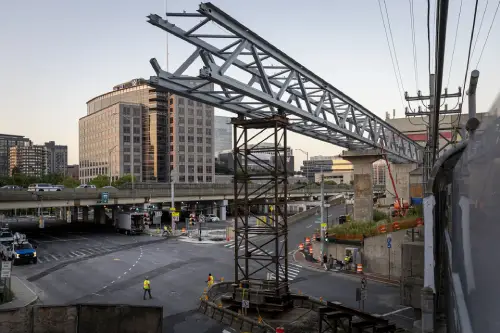

Introduction to Infrastructure
Catalog
What Is Infrastructure?Key TakeawaysUnderstanding InfrastructureTypes of InfrastructureMaintaining InfrastructureFrequently Asked QuestionsRelated ArticlesWhat Is Infrastructure?
Infrastructure refers to the essential physical systems that support a business, area, or country. It's about the things that keep everything running smoothly, like transportation, communication networks, sewage, water, and schools.

Introduction to Infrastructure
Building or improving infrastructure usually takes a lot of money and resources, but it’s key to a region’s growth and success. These projects can be funded by the government, private companies, or a mix of both (public-private partnerships).
Key Takeaways
Infrastructure is the essential systems and facilities that support a country, region, or community.
Some examples include things like public transportation and telecom networks.
Big infrastructure projects are usually handled by the government and funded by taxes.
On a smaller scale, private companies or local authorities can also build infrastructure.
There are two types of infrastructure: soft and hard. Both are super important for a society's economy and overall well-being.
Understanding Infrastructure
The word "infrastructure" first popped up in the late 1880s, coming from French—infra- means "below," and structure means "building." So, infrastructure can mean the base or foundation that holds up the rest of an economy.
It includes all kinds of systems and structures that need physical components, like the electrical grid powering a city, state, or even a whole country. While things like bridges and roads are obviously key to an economy, infrastructure also helps people get involved in the social and economic life of a community. It makes sure people have what they need, like food and water.
Because infrastructure often involves creating public goods or things that can be used by everyone, it's common for the government to fund, control, or regulate it. This usually means the government is directly involved in making it happen or works with a legal entity that’s closely supervised. The very first federally funded infrastructure project in the U.S. was the Cape Henry Lighthouse, built back in 1792 at Virginia Beach.
Sometimes, private companies also jump in and invest in infrastructure to help grow their business. For example, an energy company might build pipelines or railways in a country where it wants to refine oil, and both the company and the country benefit from the investment.
People might even fund improvements to public infrastructure themselves. For instance, someone might choose to fund upgrades to hospitals, schools, or local law enforcement.
Types of Infrastructure
Infrastructure is often split into two main types: hard and soft. Hard infrastructure is made up of the physical, tangible things like roads, bridges, tunnels, and railways. Soft infrastructure, on the other hand, includes the services that support the economy, health, and social needs of a population.
Hard Infrastructure
Hard infrastructure refers to the physical systems that are essential for a modern, industrialized nation to function. This includes things like roads, highways, and bridges, plus the equipment needed to make them work—like buses, trucks, and oil refineries. Even technical stuff like networking equipment and cabling falls under hard infrastructure since they’re critical for supporting businesses.
According to the Brookings Institution, about 16.6 million people have jobs directly related to infrastructure. That includes everyone from engineers and power line installers to truck drivers and construction workers. In fact, infrastructure jobs make up almost 11.8% of the country’s workforce!
Soft Infrastructure
Soft infrastructure is all about human resources and the institutions needed to keep an economy running smoothly and provide essential services to people—things like healthcare, banks, government offices, law enforcement, and schools.
Investing in soft infrastructure focuses on how people live and interact in society. For example, in 2021, President Biden’s Build Back Better Plan included proposals to improve soft infrastructure, like expanding Medicare and making community college tuition-free.
Maintaining Infrastructure
How infrastructure is maintained and funded usually depends on who owns it. A lot of infrastructure, like roads, water systems, and public schools, is owned by the government. Most of it is owned by state and local governments, and they often get some help through federal subsidies. But some infrastructure is fully owned by private companies.
There are also public-private partnerships when it comes to maintaining infrastructure. For example, in 2004, Cintra signed a 99-year lease with the City of Chicago to operate and maintain the Chicago Skyway Bridge. In exchange, Cintra gets all the toll and concession revenue from the bridge, while Chicago got a $1.82 billion cash boost and no longer has to take care of the bridge.
The U.S. has rolled out several major infrastructure plans, like the American Recovery and Reinvestment Act of 2009 and the $305 billion transportation infrastructure bill passed in 2015.
Then, on November 15, 2021, President Joe Biden signed the Infrastructure Investment and Jobs Act, which set aside $1.2 trillion to rebuild things like roads, bridges, water systems, and internet access.
The 2021 plan also includes big investments in newer infrastructure, like $7.5 billion to support electric vehicles and $65 billion to make sure everyone has access to reliable high-speed internet.
Frequently Asked Questions
What Is the Digital Divide?
The COVID-19 pandemic really brought to light how many parts of the U.S. have limited or no internet access, creating what's known as the digital divide. The Infrastructure Investment and Jobs Act (IIJA) of 2021 includes funding to make sure every American has access to reliable, high-speed internet.
Are Electric Vehicles Considered a Part of Infrastructure?
Yes, the IIJA is also helping fund the development of the country’s EV-charging infrastructure. The goal is to install 500,000 publicly accessible charging stations by 2030, and they’ll be compatible with all vehicles and technologies.
Why Is Infrastructure Important to a Society?
Infrastructure is what keeps businesses running, connects workers to their jobs, and gives people access to things like healthcare and education. It creates opportunities in communities, and a strong economy needs reliable infrastructure to keep supply chains moving and goods and services flowing.
What are the four types of infrastructure?
There are several types of infrastructure:
- Soft Infrastructure: These are the institutions that keep the economy running smoothly.
- Hard Infrastructure: This includes things like roads, bridges, and utilities.
- Critical Infrastructure: These are systems that are vital for national security and public safety, like energy grids and water supplies.
- Taxation: While not typically called infrastructure, taxes help fund many of the systems that make up a country's infrastructure.
- Investments: These are essential to building and maintaining infrastructure.
- Public-Private Partnerships (PPPs): These involve collaboration between the government and private companies to build and maintain infrastructure.
What are the 3 primary components of IT infrastructure?
IT infrastructure includes:
- Hardware: This is the physical stuff like servers, computers, routers, and storage systems.
- Software: This includes operating systems, applications, and tools for managing problems.
- Networking: This covers routers, switches, and cables.
What does infrastructure mean?
Infrastructure refers to the basic facilities and systems that support a country, region, or community. Examples are things like public transportation and telecom networks. Large-scale infrastructure is often built by the government and paid for by taxes.
What is infrastructure in a relationship?
In a relationship, "infrastructure" refers to the social connections, interactions, and collective knowledge that help a group or community work together, solve problems, and make changes.
What is the difference between resources and infrastructure?
Infrastructure is the foundational framework that supports an organization or country’s systems. Resources, on the other hand, are the available materials or sources in a place that can be used to build or create something valuable.
What falls under IT infrastructure?
IT infrastructure includes things like computing power, networks, workplaces, data platforms, and edge capabilities. Traditional IT infrastructure is mostly about hardware like data centers and servers, which are manually set up and managed. With modern cloud infrastructure, apps and data are accessible from anywhere.
Related Articles
Air Conditioner Capacitors: Everything You Need to Know (2025)
CBB61 Capacitors: What They Are and How to Use Them
Subscribe to JMChip Electronics !



















